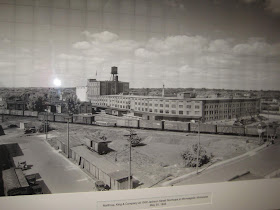Down
through the centuries, every city has had them. Small enclaves of residential housing,
usually no more than hovels and shacks, where succeeding waves of immigrants
first established themselves in a new town. The Twin Cities are no different.
Each has had its own pockets of poverty where first timers got their start
before moving up through the generations to someplace better.
Most
folks my age are locked into their own generational history and their own
decades of living in that black and white world of their parents homestead and
first neighborhood. As such, it’s easy forget all those who came before us.
Those early settlers who established their own little enclaves of like-minded
souls after the frontier had been established and towns like Saint Paul and
Minneapolis slowly began to grow into metropolitan areas. Through the decades
and multiple generations, immigrant populations all found their own areas of
settlement.
Unbeknownst
to me back then, I was on the tail end of the slow demise of a lot of those
early settlements in the Twin Cities. Back then it was my world. It shaped me.
It formed my work ethic, drive, insecurities and hunger for more.
While
our family was still whole, Irvine Park became our second neighborhood to live
in after the duplex on Smith Avenue.
Our
ancient six-plex apartment building was next door to Little Sisters of the
Poor. The Wilder Playground and daycare was up the street. DP (displaced people
from World War Two) lived in tenement housing just down the block. There was
the Gem Theater and a small ethnic neighborhood grocery store within walking
distance. Out my second story window, I could see low-income housing across the
street and the Ramsey house on the corner.
Old
East Saint Paul had all but disappeared by the time I was a grade school
commuter to downtown Saint Paul. Our relatives (mainly aunts and uncles) in
East Saint Paul would hardly acknowledge its existence. By then, the Swedes and
Norwegians were being slowly replaced with brown-skinned immigrants from south
of the border. My relatives were either isolating themselves from those
newcomers or had moved on by then.
The
West Side of Saint Paul was OK but we were cautioned to keep away from the
flats. By that time the Jews and Poles had moved on and the Mexicans had moved
in. I learned early on that my Mother still harbored the ignorance and fear of
her rural forefathers for others not like her.
Little
Italy was a tiny enclave of immigrants from Italy who worked at West
Publishing, Schmidt Brewery and Hamms Brewery in East Saint Paul. I can
remember walking along the Mississippi River and hitch-hiking my way downtown. Yearly
spring flooding finally forced the city to condemn the entire area and raze all
the houses there.
Bohemian
Flats came first and then was followed by the Gateway District. Both areas
attracted the bottom of the immigrant barrel. Both succumbed to newer
generations climbing up the economic ladder and leaving the area.
Above
the Bohemian Flats, the West Bank neighborhood sat across the Mississippi from
the University of Minnesota. By the time I arrived on scene (during my wannabe
hippie phase) it had been slowly
crumbling away for decades. By the mid-sixties, it had become just a sad
reminder of working class neighborhood it had once been.
The
Lower Town part of downtown Saint Paul was just beginning its transformation
from decrepit to decidedly middle class when my employer, Twin Cities Public
Television, moved its facilities from Como Avenue to Lower Town.
Now
in the autumn of my years a new frontier has been established in North East
Minneapolis with the convergence of the Northrup King manufacturing plant into
artist studios. The grain-milling plants, small factories and Eastern European
enclaves are slowly being replaced with artists’ lofts, new apartment buildings
and commercial development along major corridors. This time around, the artists
as well as newly arrived immigrants are forcing the changes in the area.
In
so many ways, it is still a melting pot like so many of the enclaves that came
before it. Areas of exclusion from the cookie-cutter mainstream of society. A
place for those who don’t live a nine to five existence, white picket fence and
chicken in the oven kind of life. A bit out of the mainstream and happily creating
new currents of their own.
Welcome
home again.




















































